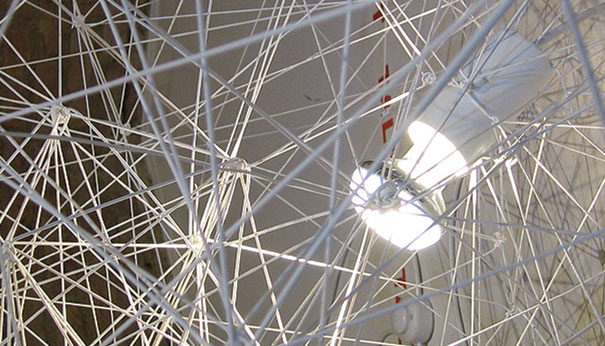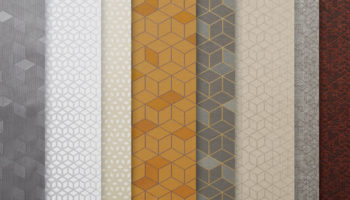Sarah Ivanyi’s Fractal, Arcal, and Cumulus Lamps
Fresh off the heels of a visit to Western Massachusetts’ burgeoning Mass Moca Museum and their current featured exhibit of Sol Lewitt’s vibrant line art, Sarah Ivanyi’s trio of geometrical light-pieces entitled Fractal, Arcal, and Cumulus strikes a particular chord (if you’ll pardon the requisite pun). There are similarities between the two, indeed. But while Lewitt’s work primarily depends on the rigorous application of specific mathematical instructions for creating intersecting straight or diagonal lines, Ivanyi’s lamps use the notion (or illusion) of “straight” to create an incipient amorphous mass.
Fractal, Arcal, and Cumulus. Designed by Sarah Ivanyi.
Ivanyi’s lamps are less a functional product than an artistic exploration into the ways we illuminate our space. Made of simple, innumerable rubber-coated metal bands, each lamp challenges the prevailing paradigms of controlled illumination by de-emphasizing the nature of the light in favor of its surrounding container. The actual light source (a simple halogen bulb attached to the wire structure via a non-descript cylindrical “microphone”) couldn’t be less distinctive. In fact—if you’ll pardon an odious comparison—the light is the functional equivalent to the orange-sheathed bare bulb endemic to dark construction sites everywhere, such is its mundanity, such does it cede center stage to the surrounding architecture.


Ivanyi has chosen to name her three pieces after (in order) a mathematical phenomenon that quantifies irregularity; an adjectival coinage that refers to intact fragments of a circumference; and the puffy cloud formations that resemble gigantic cauliflowers. Given the focus on quantifying shape, it’s apparent that Ivanyi is preoccupied with turning a specific, definable element (an arc or a fractal line) into an asynchronous mass that might resemble any number of actual, tangible items (clouds, mounds of marshmallows, an inscrutable network of gossamer created by some maddened arachnid, the dimly-lit interior of a partially-realized space station).
The upshot, I suppose, is to acknowledge and celebrate art’s (and design’s) unending propensity for turning raw material into a potent, referential form; for using the universal language of math to bolster creativity; for re-contextualizing—and therefore invigorating—familiar notions about exactly what a light is supposed to do.
Via MocoLoco




Leave a Reply